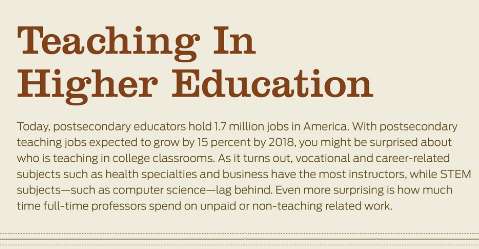
The 'Teaching in Higher Education' Infograph Shows the Numbers
Jennifer Gosnell — June 14, 2012 — Special
References: awesome.good.is
Teachers make up a vital component to any society, prompting the 'Teaching in Higher Education' infograph to take a look at American post-secondary teachers by the numbers. You may be surprised to learn that the sectors of teaching in the areas of health and vocational training far surpass any other sector. The sciences -- bio and computer in particular -- are falling behind with the number of teachers in their area.
One of the main differences that sets apart part-time and full-time professors at post-secondary education schools is their level of education. While part-time profs are found to be more likely to have a master's as their highest level, full-time profs are considerably more likely to have a PhD as theirs.
One of the main differences that sets apart part-time and full-time professors at post-secondary education schools is their level of education. While part-time profs are found to be more likely to have a master's as their highest level, full-time profs are considerably more likely to have a PhD as theirs.
Trend Themes
1. Increasing Demand for Health and Vocational Teachers - With sectors such as health and vocational training surpassing other areas in terms of the number of teachers, there is an opportunity for disruptive innovation to meet the increasing demands in these fields.
2. Shortage of Teachers in the Sciences - The falling number of teachers in bio and computer sciences presents an opportunity for innovative solutions to attract and retain educators in these fields.
3. Growing Importance of Phd Holding Professors - As full-time professors with PhDs become more prevalent in higher education, there is room for disruptive innovation in developing resources to support and collaboratively work with their specialized expertise.
Industry Implications
1. Education - With data showing discrepancies between sectors and levels of education of professors, there is a need for flexible and accessible educational pathways to support and train future teachers.
2. Healthcare and Vocational Training - The high number of teachers in health and vocational training sectors signify a growing industry in need of sustainable solutions to meet increasing demands and provide quality education.
3. STEM Education - To address the growing shortage of science teachers with specialized training and expertise, there is an opportunity for investment and support in STEM education to promote teacher development and retention.
0.5
Score
Popularity
Activity
Freshness























